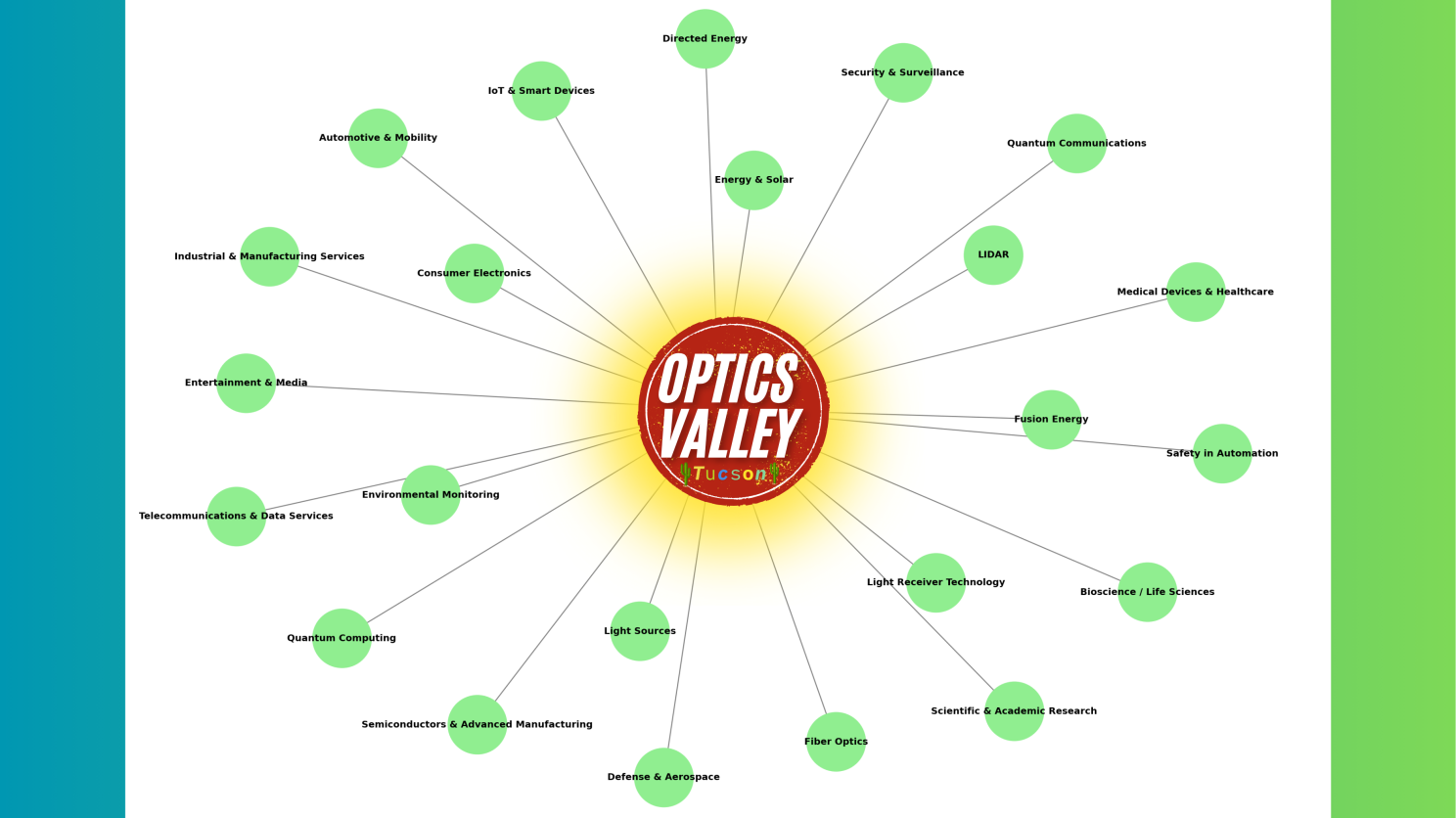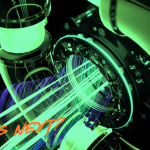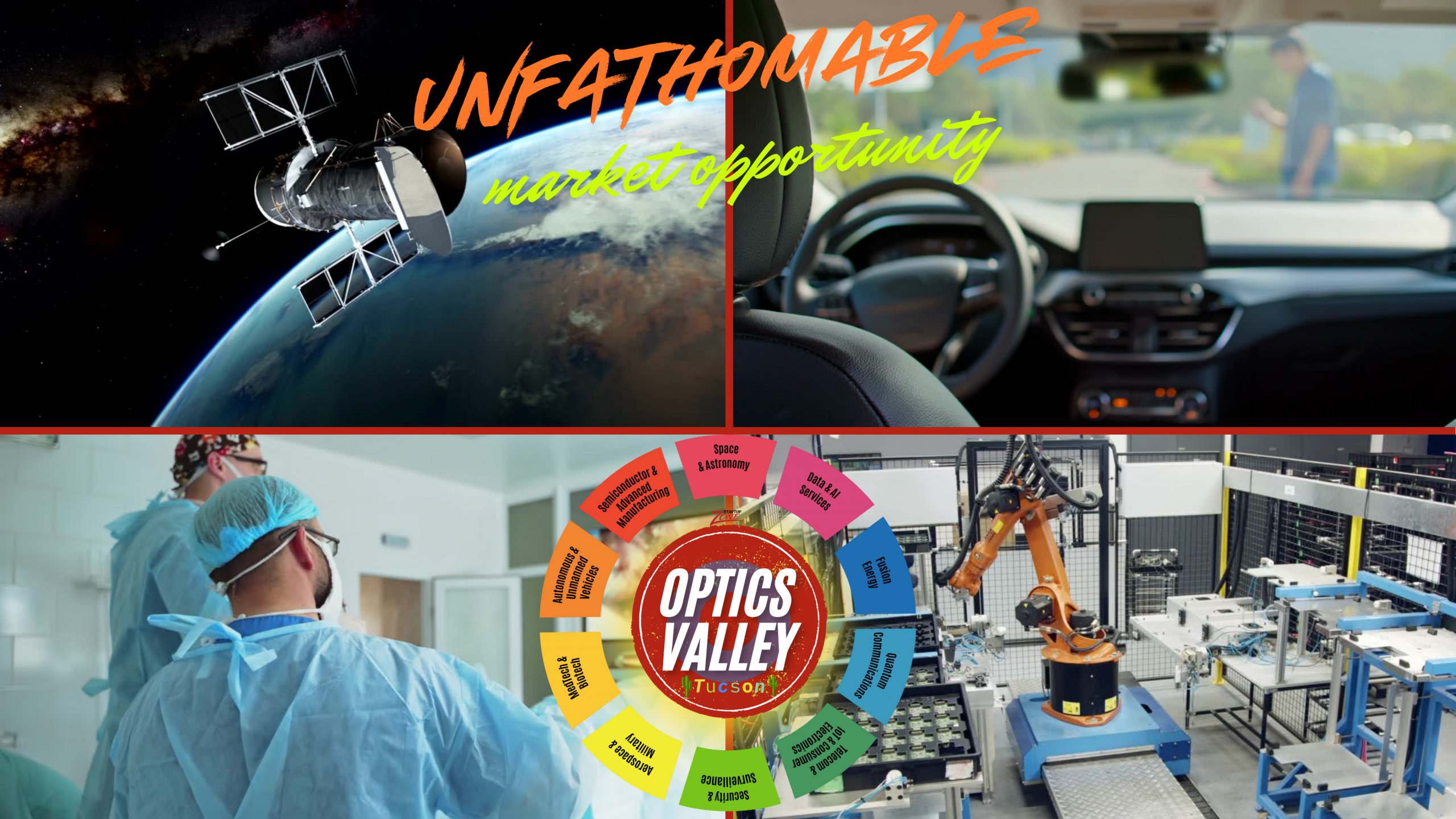Arizona’s Launchpad for the Impossible
Optics Valley – Shaping the next era of global innovation.
I’m switching gears, focusing on the market opportunity rather than core technologies impacting a specific sector. I hope that you enjoy the change of pace.
Tucson (Optics Valley), Pima County, and the State of Arizona sit on a unique and under-leveraged advantage, an optics and photonics ecosystem recognized worldwide as Optics Valley. This is more than a regional brand. It’s a global differentiator, a center of technical excellence that can attract the world’s most ambitious tech companies not because they want to be here, but because they need to be here.
If our region leans in, Optics Valley can be where the next generation of industry-defining products are conceived, built, and scaled by companies who know they can’t achieve their goals without us.
The World Builds With Light and We Own the Playbook
Optics and photonics are enabling technologies. That means they’re not just an industry in themselves; they’re the invisible engines that make countless other sectors possible. Whenever a company needs precision sensing and metrology, high-speed data transfer, advanced imaging, laser, or optical communication, it taps into Optics Valley.
From autonomous vehicles that “see” using LiDAR, to medical devices that can image the inside of the human body in 3D without a single incision, to space telescopes that push the boundaries of human understanding, none of these exist without optics and photonics.
Optics Valley has decades of unmatched expertise in turning photons into progress. Our companies, researchers, and engineers have solved problems that others worldwide couldn’t from ultra-high precision manufacturing to deep space observation. That’s a powerful lure for companies whose competitive edge depends on seeing, measuring, cutting, or transmitting light better than their rivals.
Why Tech Companies Need to Come Here
When a tech company decides to base an innovation project in Tucson or Pima County, they’re not choosing a desert city for the weather. They’re choosing proximity to the experts, tools, workforce, and networks that can make or break their product roadmap.
- World-Class R&D – The University of Arizona’s Wyant College of Optical Sciences is a powerhouse for applied research and talent.
- Specialized Manufacturing Capability – Precision optics fabrication, advanced laser systems, metrology, and custom photonic integration. The region has suppliers and labs that can go from concept to prototype to scale faster than anywhere else.
- Talent Depth – Optical engineers, physicists, materials scientists, and technicians trained here aren’t just skilled; they specialize in the frontier challenges of light-based technology.
- Cross-Industry Reach – The same photonics expertise that serves aerospace primes also serves med-tech startups, semiconductor giants, and defense contractors.
For a company developing a next-gen augmented reality headset, locating part of their operation here means fewer blind spots in design, faster iteration, and access to specialized testing that can cut months or years off time-to-market.
The Global Signal We Need to Send
Other regions have strong optics players, but few have a regional identity wrapped around the technology. The name “Optics Valley” itself is a beacon. It tells the world:
If your innovation depends on light, you need to be here.
Arizona’s marketing should stop hiding optics and photonics under broader “advanced manufacturing” or “aerospace” categories. We should lead with it. In every global pitch, every economic development mission, every tech conference booth, the message should be:
- We are the premier place to solve your most complex optics and photonics challenges.
- We have the team, the tools, and the track record to accelerate your breakthroughs.
- You can’t out-innovate us, but we’ll help you out-innovate your competitors.
What Attraction Could Look Like in Practice
If Pima County and Arizona put Tucson (Optics Valley) front and center, here’s what we could see in the next five years:
- Dedicated Optics Valley Landing Program – A fast-track pathway for companies to set up R&D or prototype facilities here, with concierge access to university labs, supplier networks, and top talent.
- Joint Innovation Projects – Partnering regional optics firms with out-of-state tech companies to co-develop critical components, splitting IP and market share.
- Specialized Testbed – Facilities for automotive LiDAR calibration, AR/VR optics testing, satellite imaging payload validation, and medical imaging device certification.
- Talent Magnet Programs – Fellowships, internships, and residency-style programs for top optical engineers worldwide to embed here for 6-12 months.
- Startups and joint ventures can drive stable and sustainable growth vs focusing on attracting large companies to relocate. These same companies can mitigate brain drain and improve workforce development.
The Competitive Reality: If We Don’t Claim It, Others Will
Markets move fast. If Arizona doesn’t loudly own the position of #1 destination for optics-enabled innovation, other states or countries will seize it.
We’ve already seen optics clusters emerging globally, but none have our combination of brand recognition, depth of expertise, and cross-sector capability.
By leading with Optics Valley, we’re not just defending our position but expanding it.
Why This Benefits Everyone in the Region
Focusing on attracting companies that need our optics and photonics expertise has significant growth ripple effects:
- High-Quality Job Creation – These are not minimum-wage assembly jobs but high-skill engineering, research, technician, and production roles.
- Supply Chain Strengthening – More companies here mean more demand for local precision machining, 3D printing, coatings, software, and electronics suppliers.
- Cross-Pollination – A med-tech startup from Boston might bring new processes that a Tucson aerospace company can adapt and vice versa.
- Global Reputation – Tucson’s name becomes synonymous with high-stakes problem solving as more world-class companies drive core innovation here.
The Call to Action
We have a choice: treat Optics Valley as a quiet local specialty, or leverage it as our primary magnet for high-impact tech companies worldwide.
That means:
- Pima County builds targeted incentives and site-readiness programs for optics-enabled tech firms.
- The State of Arizona features Optics Valley as a signature industry in global economic development campaigns.
- Industry & Academia double down on joint outreach, proof-of-concept collaborations, and workforce pipelines tied to optics-heavy industries.
- The Startup Ecosystem encourages photonics-enabled startups to launch, develop, co-locate, and scale here. This, feeding and building a larger cluster.
Final Word
Light powers the future, and in Tucson (Optics Valley), Pima County, and across Arizona, we know how to shape it better than almost anyone. Suppose we position Optics Valley as the indispensable partner to the world’s most ambitious tech companies. In that case, we won’t just grow our local economy; we’ll become where the next generation of game-changing innovations will be born.
The opportunity is here, right now. All we have to do is signal to the world: if your product depends on light, your future runs through Optics Valley.
BONUS – INDUSTRIES AND PRODUCTS
Nearly All Industries Rely on Optics and Photonics

Major Optics & Photonics Component Families
The following is a small sampling of the thousands of components used in modern technology. The pace of innovation is growing rapidly, and so will the parts manufactured. This small list is to demonstrate the scale of the opportunity.
- Light sources: semiconductor (edge‑emitters, VCSELs), solid‑state/fiber, gas (HeNe, CO₂, excimer), ultrafast systems, supercontinuum, plus QCLs for mid‑IR.
- Modulation & switching: EO (Pockels/MZM), EAM, AOM/AOD, LCoS/SLMs, DMD, thermo‑optic & MEMS switches.
- Frequency conversion & combs: SHG, OPO/OPA/OPCPA, optical frequency combs; common nonlinear crystals (BBO, LBO, KTP, PPLN/PPKTP).
- Fiber & passive: SMF/MMF/PM, photonic‑crystal & hollow‑core, FBGs/LPGs, couplers & splitters (FBT/PLC), VOAs, isolators/circulators, EDFAs/Raman/SOAs, WDM/CWDM/DWDM, OADM/ROADM.
- Integrated photonics: Si/SiN/InP PIC building blocks (grating couplers/edge couplers, MZIs, rings, AWGs), on‑chip lasers & Ge/InGaAs PDs, thermo/MEMS switching.
- Beam delivery & optics: lenses (aspheres/achromats/GRIN), prisms, mirrors, beam splitters (NPBS, polarizing, dichroic), polarizers & waveplates, DOEs/VPH gratings, interferometers/etalons, high‑power coatings/windows (sapphire/CaF₂/ZnSe
- Detectors/receivers: PIN & APD, SPAD & SPAD arrays, SNSPD, PMT/MCP‑PMT/HPD, SWIR InGaAs, MWIR/LWIR HgCdTe (MCT), microbolometers, CCD/CMOS/sCMOS, coherent I/Q receivers.
- Spectroscopy & metrology: grating & FTIR spectrometers, OTDR, OCT, power meters/beam profilers, ellipsometry/polarimetry, white‑light interferometry.
- LiDAR & 3D sensing: 905/1550 nm sources, MEMS/galvo/polygon/OPA scanning, APD/SPAD & coherent FMCW receivers, VCSEL flood/dot projectors.
- Directed energy & high‑power: adaptive optics (DMs/fast steering), beam combining, dumps/shutters/windows for power handling.
- Quantum: single‑photon sources (SPDC, QDs), detectors (SNSPD/TES/PNRD), integrated quantum photonics, quantum memories/repeaters.
- Safety in automation: safety light curtains (IR LED Tx + photodiode Rx), safety LiDAR, telecentric optics for measurement.
- Displays/AR‑VR/meta‑optics: LCoS, microOLED/microLED, diffractive/holographic waveguides, pancake optics, metalenses.
- Energy (PV & fusion): CPV optics (Fresnel/heliostats/LSC), coatings & spectral splitters, NIF‑class optics (KDP/DKDP, Pockels cells).








